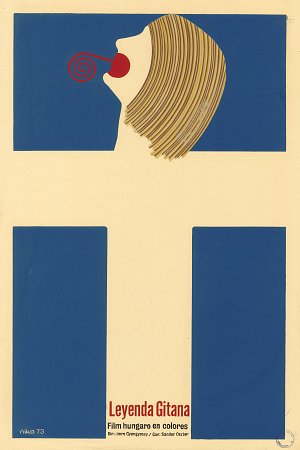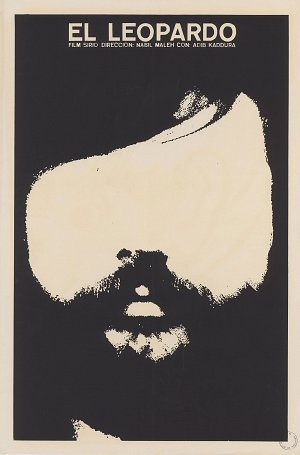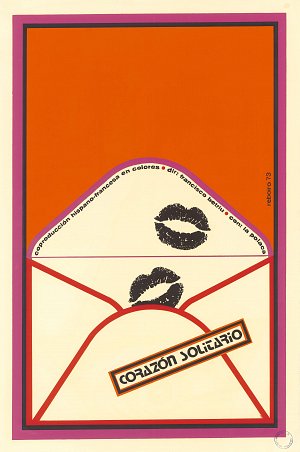
Niko (a.k.a. Antonio Perez Gonzales), Leyenda gitana
Dir: Imre Gyongyossy
© MAD, Paris
While posters started appearing on the island from the late 19th century, it was not until the revolution that poster design became a more elaborate artistic practice. Until 1959, posters were primarily commercial, encouraging the consumption of imported products and following the aesthetic example set by American advertising. At the Revolution’s close in 1959, Che Guevara – appointed Minister of Industry – banned commercial advertising and posters consequently started reflecting the politics and culture of the era.
Cuban political posters found their inspiration in the historic events of the Revolution and feature its heroic figures, with subjects such as: Fidel Castro’s first attempt to overthrow General Fulgencio Batista with the attack on the Moncada Barracks in Santiago de Cuba in 1953; the establishment of the revolutionary “26 July Movement”; the comrades in arms of the Guerrilla campaign with the figures of Che and Camilo Cienfuegos; the capture of Havana and power by the Guerrilla forces in 1959; and the invasion of the Bay of Pigs by the United States in reaction to Cuba’s strengthening ties with the Union of Soviet Socialist Republics (USSR).
-

Dimas (a.k.a. Jorge Dimas Gonzales Linares)
ICAIC, 1973
© MAD, Paris
-

Olivio Martinez, October 8: Day of the Heroic Guerrilla OSPAAAL
OSPAAAL, 1973
© MAD, Paris / photo: Christophe Dellière
The Organisation of Solidarity of the People of Asia, Africa and Latin America (OSPAAAL) and the Department of Revolutionary Orientation (DOR) were the two main organisations publishing political posters during this period. OSPAAAL was in charge of issues concerning international solidarity – in particular with the developing world – and DOR dealt with the country’s revolutionary orientation. Felix Beltran and Alfredo Rostgaard’s beguiling work epitomizes the posters printed by both governmental agencies.
Cultural posters, on the other hand, were almost exclusively linked to cinema, an industry that played an integral part in Cuba’s history. In 1943, there were 422
movie theatres across the country. Fidel Castro designated film the “seventh art,” claiming it as one of the principle tools for educating the people and implementing
his cultural policies.

René Azcuy Cardenas, El Leopardo film sirio
ICAIC
© MAD, Paris
From the time of its creation in 1959, the Cuban Institute of Cinematographic Art and Industry (ICAIC) became the most important source of poster commissions. It quickly imposed novel styles that favoured the Cuban poster
design exemplified by key figures such as René Azcuy Cardenas, Niko, Eduardo
Munoz Bachs and Antonio Reboiro, and which garnered the Cuban poster art
international recognition.
Cuban cinema posters started evading the aesthetic conventions established by local
branches of American communications agencies before the revolution. Rather
than present a portrait of the leading actor or a film still, Cuban poster artists employed free and creative interpretation of the films’ narratives. Considered
an instrument of propaganda after the revolution, it was mandated that posters
educate viewers about art and incite pleasure. Poster artists started drawing inspiration from contemporary art movements including pop, psychedelic,
and kinetic art. Unlike other communist regimes that mandated an adherence to
a social realist aesthetic included in poster design, Fidel Castro advocated total
freedom of form, seeing the poster as a “large-format visual manifestation within
reach of the people who frequent neither museums nor galleries.”

Eduardo Munoz Bachs, Ichi y la fugitiva
Direccion: Kimiyoshi Yasuda, ICAIC, 1973
© MAD, Paris
Cuban posters were highly sought-after until policies implemented in the mid 1980‘s brought forth events that would lead to the eventual fall of the Soviet Bloc and with it 80% of the export trade on which Cuba relied. Cuba entered a deep economic crisis and poster production came to an abrupt halt. Young graduates of the Instituto Superior de Diseño (ISDi) consequently began their careers within a context of significantly reduced public commissions. Designers joined forces
in small, independent groups such as Next Generation (1993-1997), founded
by Pépé Menéndez.
Work created by the collective NUDO, formed by Eduardo Marin and Vladimir Llaguno, demonstrates a provocative rebellion against previously accepted rules of graphic design. The 2000s saw the arrival of a new generation
of Cuban poster designers that would undertake a resolutely experimental artistic
practice.
The exhibition’s chronological and monographic layout introduces viewers to Cuba’s history through the political posters, contextualising the major events that inspired the artists of the revolutionary period.

Antonio Reboiro, Corazon solitario
Dir: Francisco Betriu, ICAIC, 1973
© MAD, Paris
It continues with film posters and an exploration of the ICAIC,
one of the greatest commissions of such work, featuring the designs of major figures such as René Azcuy Cardenas, Niko, Eduardo Munoz Bachs and Antonio Reboiro. Finally, the exhibition explores the new generation of artists, revealing the richness of contemporary production. It includes pieces from the private collection of Luigi Bardellotto, never before seen in France.
Affiches cubaines : révolution et cinéma, 1959-2019 invites visitors to
explore a graphic cultural heritage that
is little known today, resituating it in its
rightful place within the international
history of poster design.